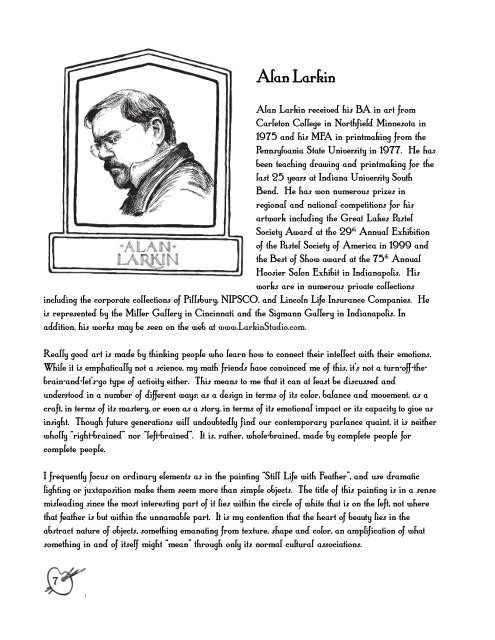University Club - Richard Luschek
University Club - Richard Luschek
University Club - Richard Luschek
You also want an ePaper? Increase the reach of your titles
YUMPU automatically turns print PDFs into web optimized ePapers that Google loves.
Alan Larkin<br />
Alan Larkin received his BA in art from<br />
Carleton College in Northfield Minnesota in<br />
1975 and his MFA in printmaking from the<br />
Pennsylvania State <strong>University</strong> in 1977. He has<br />
been teaching drawing and printmaking for the<br />
last 25 years at Indiana <strong>University</strong> South<br />
Bend. He has won numerous prizes in<br />
regional and national competitions for his<br />
artwork including the Great Lakes Pastel<br />
Society Award at the 29 th Annual Exhibition<br />
of the Pastel Society of America in 1999 and<br />
the Best of Show award at the 75 th Annual<br />
Hoosier Salon Exhibit in Indianapolis. His<br />
works are in numerous private collections<br />
including the corporate collections of Pillsbury, NIPSCO, and Lincoln Life Insurance Companies. He<br />
is represented by the Miller Gallery in Cincinnati and the Sigmann Gallery in Indianapolis. In<br />
addition, his works may be seen on the web at www.LarkinStudio.com.<br />
Really good art is made by thinking people who learn how to connect their intellect with their emotions.<br />
While it is emphatically not a science, my math friends have convinced me of this, it’s not a turn-off-thebrain-and-let’s-go<br />
type of activity either. This means to me that it can at least be discussed and<br />
understood in a number of different ways: as a design in terms of its color, balance and movement, as a<br />
craft, in terms of its mastery, or even as a story, in terms of its emotional impact or its capacity to give us<br />
insight. Though future generations will undoubtedly find our contemporary parlance quaint, it is neither<br />
wholly “right-brained” nor “left-brained”. It is, rather, whole-brained, made by complete people for<br />
complete people.<br />
I frequently focus on ordinary elements as in the painting “Still Life with Feather”, and use dramatic<br />
lighting or juxtaposition make them seem more than simple objects. The title of this painting is in a sense<br />
misleading since the most interesting part of it lies within the circle of white that is on the left, not where<br />
that feather is but within the unnamable part. It is my contention that the heart of beauty lies in the<br />
abstract nature of objects, something emanating from texture, shape and color, an amplification of what<br />
something in and of itself might “mean” through only its normal cultural associations.<br />
7


